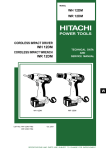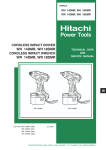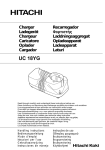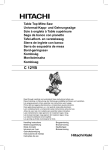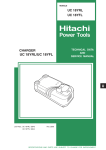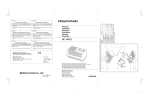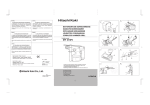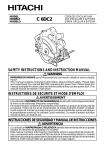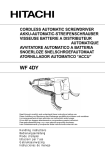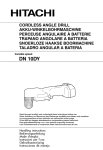Download UC 24YFA - Cloudfront.net
Transcript
MODEL UC 24YFA POWER TOOLS CHARGER UC 24YFA TECHNICAL DATA AND SERVICE MANUAL U LIST No. F845 Mar. 2001 SPECIFICATIONS AND PARTS ARE SUBJECT TO CHANGE FOR IMPROVEMENT CONTENTS Page 1. PRODUCT NAME ........................................................................................................................... 1 2. MARKETING OBJECTIVE ............................................................................................................. 1 3. APPLICATIONS .............................................................................................................................. 1 4. SELLING POINTS .......................................................................................................................... 2 4-1. Selling Point Descriptions ............................................................................................................... 3 5. SPECIFICATIONS .......................................................................................................................... 7 5-1. Specifications .................................................................................................................................. 7 5-2. Comparisons with Similar Products ................................................................................................ 7 6. PRECAUTIONS IN SALES PROMOTION ..................................................................................... 8 6-1. Safety Instructions .......................................................................................................................... 8 6-2. Extra Precautions in Sales Promotion ............................................................................................ 9 7. QUESTIONS AND ANSWERS ON MODEL UC 24YFA .............................................................. 10 8. GENERAL PRECAUTIONS ......................................................................................................... 13 8-1. Model UC 24YFA .......................................................................................................................... 13 8-2. Pilot Lamp Indications ................................................................................................................... 14 9. PRECAUTIONS IN DISASSEMBLY AND REASSEMBLY .......................................................... 15 9-1. Disassembly ................................................................................................................................ 15 9-2. Reassembly .................................................................................................................................. 15 9-3. Confirmation after Reassembly .................................................................................................... 15 10. TROUBLESHOOTING GUIDE ................................................................................................... 16 10-1. Troubleshooting Based on Pilot Lamp Indications ...................................................................... 16 10-2. Troubleshooting and Repair Procedures .................................................................................... 16 11. STANDARD REPAIR TIME (UNIT) SCHEDULES...................................................................... 20 Assembly Diagram for UC 24YFA 1. PRODUCT NAME Hitachi Charger, Model UC 24YFA 2. MARKETING OBJECTIVE As the cordless tool market expands year by year, customers have come to expect a wider range of high-voltage products, longer run time with high-capacity batteries, and lower prices. The Model UC 24YFA, a rapid and lowprice charger, has been developed by making improvements to the current Model UC 24YF that is capable of recharging both nickel cadmium (Ni-Cd) and nickel metal hydride (Ni-MH) batteries from 7.2 V to 24 V in one hour. 3. APPLICATIONS Recharging of Hitachi batteries Applicable batteries: Ni-Cd batteries EB 7 EB 9 EB 12 EB 7S EB 9S EB 12S EB 14S EB 7G EB 9G EB 12G EB 9B EB 12B EB 14B EB 18B EB 1820 EB 24B EB 9M EB 12M EB 924 EB 1224 EB 1424 EB 1414 EB 1814 [7.2 V, [9.6 V, [12 V, [7.2 V, [9.6 V, [12 V, [14.4 V, [7.2 V, [9.6 V, [12 V, [9.6 V, [12 V, [14.4 V, [18 V, [18 V, [24 V, [9.6 V, [12 V, [9.6 V, [12 V, [14.4 V, [14.4 V, [18 V, 1.3 Ah] 1.3 Ah] 1.3 Ah] 1.3 Ah] 1.3 Ah] 1.3 Ah] 1.3 Ah] 1.7 Ah] 1.7 Ah] 1.7 Ah] 2.0 Ah] 2.0 Ah] 2.0 Ah] 2.0 Ah] 2.0 Ah] 2.0 Ah] 2.0 Ah] 2.0 Ah] 2.4 Ah] 2.4 Ah] 2.4 Ah] 1.4 Ah] 1.4 Ah] Ni-MH batteries EB 9H EB 12H EB 14H EB 930H EB 1230H EB 1430H EB 1830H EB 2430H [9.6 V, [12 V, [14.4 V, [9.6 V, [12 V, [14.4 V, [18 V, [24 V, 2.2 Ah] 2.2 Ah] 2.2 Ah] 3.0 Ah] 3.0 Ah] 3.0 Ah] 3.0 Ah] 3.0 Ah] 1 4. SELLING POINTS (1) Accepts both Ni-MH and Ni-Cd batteries (2) Rapidly charges all Hitachi EB-series batteries Charging time: 1.3 Ah • • • • • • • • • • • • • • • • • 35 minutes 2.0 Ah • • • • • • • • • • • • • • • • • 50 minutes 1.4 Ah • • • • • • • • • • • • • • • • • 40 minutes 2.2 Ah • • • • • • • • • • • • • • • • • 55 minutes 1.7 Ah • • • • • • • • • • • • • • • • • 45 minutes 2.4 Ah • • • • • • • • • • • • • • • • • 60 minutes 3.0 Ah • • • • • • • • • • • • • • • • • 70 minutes (3) Hitachi original charge control mechanism for longer battery life Recharging/discharging cycles of battery (ambient temperature range between 10 ˚C and 30 ˚C) • Ni-Cd: about 1,000 times • Ni-MH: about 500 times General-purpose charger capable of recharging 7.2 V to 24 V batteries EB 7 EB 7S EB 9 EB 9S EB 9B EB 9M EB 924 EB 9H EB 930H EB 12 EB 12S EB 12B EB 12M EB 1224 EB 12H EB 1230H EB 1414 EB 14S EB 14B EB 1424 EB 14H EB 1430H EB 1814 EB 1830H EB 1820 EB 18B EB 24B EB 2430H 3-way overcharging protection systems for longer battery and charger life Easy-to-read visual display of charging status through constant lighting or flashing of red and green pilot lamps Fig. 1 2 4-1. Selling Point Descriptions 4-1-1. Capable of handling both nickel cadmium (Ni-Cd) and nickel metal hydride (Ni-MH) batteries Through application of HITACHI-microcomputer and electronic-circuit control technology, Model UC 24YFA is capable of handling both Ni-Cd and Ni-MH batteries. 4-1-2. Rapidly charges all Hitachi EB-series batteries: Recharging time for 2.0 Ah battery has been reduced to approx. 50 minutes and 3.0 Ah battery to approx. 70 minutes. Table 1 shows the charging time for each battery. Table 1 Recharging time (approx. min.) at 20 ˚C Battery voltage (V) 7.2 V 9.6 V 12 V 14.4 V 18 V Battery capacity (Ah) 1.3 Ah EB7 1.4 Ah 35 min. EB7S EB9 35 min. EB9S EB12 35 min. 1.7 Ah EB7G 45 min. EB9G 45 min. EB9B EB12G 45 min. EB12S EB14S 35 min. EB1414 40 min. EB1814 40 min. 24 V 2.0 Ah 2.2 Ah 2.4 Ah 3.0 Ah 70 min. 50 min. EB9H 55 min. EB924 60 min. EB930H 50 min. EB12H 55 min. EB1224 60 min. EB1230H 70 min. EB14B 50 min. EB14H 55 min. EB1424 60 min. EB1430H 70 min. EB9M EB12B EB12M EB1820 50 min. EB1830H 70 min. EB24B 50 min. EB2430H 70 min. EB18B : Ni-MH batteries NOTE: The recharging time may vary according to the ambient temperature and the power supply voltage. 4-1-3. Recharging/discharging cycles of battery (ambient temperature range between 10 ˚C and 30 ˚C) • Ni-Cd battery: about 1,000 times • Ni-MH battery: about 500 times 4-1-4. Capable of recharging batteries with internal temperatures as high as 60 ˚C When a battery with S terminal is used, as shown in Fig. 3 and Fig. 4, the 60 ˚C thermistor operates to permit recharging of batteries heated up to 60 ˚C, and as shown in Fig. 5 and Fig. 6, the 55 ˚C thermistor operates heated up to 55 ˚C. (Note 1) • Wiring diagrams for batteries are shown below. • The 95 ˚C thermal protector in the batteries EB 14S, EB 14B, EB 1424, EB 14H, EB 1430H, EB 18B, EB 24B and EB 2430H interrupts the recharging circuit when the battery temperature reaches 95 ˚C. • A discriminating resistor is provided in Ni-MH batteries EB 9H, EB 930H, EB 12H, EB 1230H, EB 14H, EB 1430H and EB 2430H to distinguish them from Ni-Cd batteries. • Because Ni-MH batteries EB 9H, EB 930H, EB 12H, EB 1230H, EB 14H, EB 1430H and EB 2430H are heated to high temperatures during recharging, this charger operates within a range of a 10 ˚C temperature difference between the maximum battery temperature when starting recharging (45 ˚C) and the temperature when stopping recharging (55 ˚C). 3 60 ˚C Thermistor (Models UC 24YC, UC 24 YF, UC 14YF2, UC 14YF, UC 12YF, UC 12YD and UC 12YB) 40 ˚C Thermostat (Models UC 12Y and UC 12YA) 40 ˚C Thermostat + Terminal T + Terminal Terminal -- Terminal (Terminal positions) T Terminal S Terminal -- Terminal (Terminal positions) Fig. 2 Ni-Cd batteries (EB 7, EB 9 and EB 12) Fig. 3 Ni-Cd batteries (EB 7S, EB 9S and EB 12S, EB 7G, EB 9G, EB 12G, EB 9B, EB 12B, EB 9M, EB 12M, EB 924 and EB 1224) 95 ˚C Thermal protector 60 ˚C Thermistor + Terminal S Terminal -- Terminal -- Terminal (Terminal positions) Fig. 4 Ni-Cd batteries (EB 14S, EB 14B, EB 1424, EB 1414, EB 1814, EB 1820, EB 18B and EB 24B) 95 ˚C Thermal protector Discriminating resistor Discriminating resistor 55 ˚C Thermistor + Terminal + Terminal S Terminal T Terminal Terminal T Terminal -- Terminal (Terminal positions) -- Terminal Fig. 5 Ni-MH batteries (EB 9H, EB 12H, EB 930H, and EB 1230H) S 55 ˚C Thermistor -- Terminal (Terminal positions) Fig. 6 Ni-MH batteries (EB 14H, EB 1430H, EB 1830H and EB 2430H) 4 4-1-5. 3-way overcharge protection system Overcharge protection is ensured by a (A) system or dT/dt system (for Ni-MH battery), (B) built-in battery temperature sensors (thermostat and thermistor) and (C) a timer. Overcharge range 2 V Battery internal gas pressure Battery temperature Battery voltage Battery voltage 55˚C Thermistor dT/dt 60˚C Thermistor 40˚C Thermostat Ni-MH Battery temperature 30~60-Minute timer Ni-Cd Battery temperature Charging time Battery internal gas pressure Fig. 7 Relationships of time, voltage, temperature and gas pressure while charging (A) • : This detects the increase in battery voltage at the end of charging using the value and suspends charging. dT/dt : This system is applicable to Ni-MH batteries. This detects the variation of Ni-MH battery temperature by the value dT/dt at the end of charging and suspends charging. (B) • Built-in battery temperature sensors : In the event the system fails to detect the voltage change, the 40 ˚C thermostat or the 60 ˚C thermistor stops charging when battery temperatures reach their respective values. (C) • Timer : Should both the system, dT/dt system and the temperature sensors fail, the timer automatically stops charging within 120 minutes from the beginning of charging. (Note 2) The voltage of the battery increases during charging and begins to fall when further charging is not possible. The system detects the point where the voltage begins to fall, and suspends charging to protect the battery from overcharging. (Note 3) The temperature rise during charging of a Ni-MH battery is higher than with a Ni-Cd battery, and a sudden temperature rise occurs just before the battery is fully charged. The dT/dt system detects the point where the temperature rises suddenly and suspends charging to minimize the temperature rise. (Note 4) As shown in Fig. 7, the pressure of gas generated after a battery has become fully charged rises rapidly to cause high temperature and high gas pressure that degrade the effectiveness of the battery. If charging is allowed to continue, the pressure of the gas will activate the safety valve in the battery, and the electrolyte will begin leaking. 5 4-1-6. Easy-to-read visual display of charging status through constant lighting or flashing of red and green pilot lamps Pilot lamp indications Red pilot lamp remains lit or flashes Green pilot lamp is lit Prior to charging Blinks During charging Lights Charging completed Blinks Charging not possible Flickers High battery temperature Lights 0.5 sec. ON 0.5 sec. OFF Stays ON constantly 0.5 sec. ON 0.5 sec. OFF 0.1 sec. ON 0.1 sec. OFF Stays ON constantly Battery or charger is faulty. Charging not possible because battery temperature is too high. Charging of heated (high temperature) batteries Battery Type Battery temperature range during charging Heated (high temperature) battery EB 7, EB 9, EB 12 ---5 ˚C --- 40 ˚C Green pilot lamp lights. When battery temperature is reduced to 40 ˚C, green pilot lamp goes OFF and charging begins. EB 7S, EB 7G, EB 9S, EB 9G, EB 9B, EB 9M, EB 924, EB 12S, EB 12G, EB 12B, EB 12M, EB 1224, EB 14S, EB 1414, EB 14B, EB 1424, EB 1814, EB 18B, EB 1820, EB 24B ---5 ˚C --- 60 ˚C Green pilot lamp lights. When battery temperature is reduced to 60 ˚C, green pilot lamp goes OFF and charging begins. 0 ˚C --- 45 ˚C Green pilot lamp lights. When battery temperature is reduced to 45 ˚C, green pilot lamp goes OFF and charging begins. EB 9H, EB 930H EB 12H, EB 1230H EB 14H, EB 1430H, EB 1830H, EB 2430H 6 5. SPECIFICATIONS 5-1. Specifications Item Descriptions Power source AC single-phase, 50 Hz or 60 Hz Power input 90 W Charging system Constant current charge with feedback control Overcharging protection system (1) Battery voltage detection ( system) for Ni-Cd battery Ni-MH battery temperature detection (dT/dt system) for Ni-MH battery (2) Battery surface temperature detection (thermostat or thermistor) (3) 120 minutes timer Charging voltage 7.2 V --- 24 V Charging current 2.5 A Charging time Approx. 50 minutes (for 2.0 Ah) Product weight 0.6 kg Operating ambient temperature range 0 ˚C --- 40 ˚C 5-2. Comparisons with Similar Products HITACHI B UC 24YFA Charging time min. 50 (2.0 Ah) 50 (2.0 Ah) Charging voltage V 7.2 --- 24 7.2 --- 24 Charging current A 2.5 2.5 Power input W 90 (90) Operating ambient temperature range ˚C 0 --- 40 4 --- 41 Chargeable battery temperature range ˚C (*1) ---5 --- 60 (*2) 0 --- 45 4 --- 41 Overcharge protection system --- system, dt/dt system, battery surface temperature detection, timer Peak cut mm 226 x 110 x 75 118 x 154 x 80 kg 0.6 (1.3 lbs.) 0.6 (1.3 lbs.) External dimensions (length x width x height) Weight (*1): Chargeable Ni-Cd battery temperature range (*2): Chargeable Ni-MH battery temperature range 7 6. PRECAUTIONS IN SALES PROMOTION 6-1. Safety Instructions In the interest of promoting the safest and most efficient use of the Model UC 24YFA Charger by all of our customers, it is very important that at the time of sale the salesperson carefully ensures that the buyer seriously recognizes the importance of the contents of the Handling Instructions. 6-1-1. Handling instructions Salespersons must be thoroughly familiar with the contents of the Handling Instructions in order to give pertinent advice to the customer. (1) Connect the charger to an AC power outlet only. Use of any other power source (DC outlet, fuel-powered generator, etc.) will cause the charger to overheat and burn out. (2) Do not use any voltage-increasing equipment (transformer, voltage regulator, etc.) between the power source and the charger. If the charger is used with voltage over and above that indicated on the unit, it will not function properly. (3) Conduct battery charging in an ambient temperature range of 0 ˚C --- 40 ˚C. If charging is attempted when the ambient temperature is below 0 ˚C, overcharging occurs because the thermistor and thermostat do not function properly, thereby reducing the service life of the battery. If charging is attempted when the ambient temperature is above 40 ˚C, charging is not possible for the EB 7, EB 9 and EB 12 batteries because the thermostat is immediately activated to stop charging. While it is possible to charge batteries with an S terminal at higher temperatures, the service life of the batteries may be considerably reduced. (4) Do not use the charger for successive charging. In very hot locations, if two or more batteries are charged successively the temperature of the charger will rise excessively, and might cause the charger to fail. Instruct the customer to wait at least 15 minutes before commencing next charging. Particular care is necessary in summer or tropical countries when the power source voltage is high. (5) Do not insert foreign objects into the air vent on the charger. The charger case is equipped with air vents to protect the internal electronic components from overheating. Caution the customer not to allow foreign materials, such as metallic or inflammable objects, to be dropped or inserted into the air vents. This could cause electrical shock, fire or other serious hazards. (6) Do not attempt to disassemble the charger. Incorrect parts replacement and/or wiring will cause malfunctions which could result in fire or other hazards. Instruct the customer to bring the charger to an authorized service center in the event repair or replacement is necessary. 8 6-2. Extra Precautions in Sales Promotion The following points must be given during sales promotion. 6-2-1. Charging may not be possible when the battery temperature is high Charging may not be possible if the temperature of the battery is high after it has been exposed to direct sunlight for a long time or immediately after it has been used. The customer should be advised in such a case to place the battery in a shaded area with good airflow, and allow sufficient cooling before recharging. This phenomenon is common to all existing batteries and chargers which employ temperature sensitive overcharge protection devices. The cooling time required before recharging varies from a few minutes to about 30 minutes, depending on the load, duration of use and ambient temperature. 6-2-2. Inserting a battery into a charger in reverse direction can cause serious damage to the battery and the charger Inadvertently inserting a battery into the charger in the reverse direction will not only make it impossible to charge the battery, it can also cause such damage as deformed terminals on the charger and the battery. Customers should be advised to confirm that the battery terminals are correctly aligned before inserting the battery into the charger. 6-2-3. B-2 (7.2 V) and B-3 (9.6 V) batteries cannot be recharged with the Model UC 24YFA (1) Because the shape of the B-2 (7.2 V) battery is different from others, it cannot be connected to the Model UC 24YFA. (2) Even if the B-3 (9.6 V) battery is connected to the Model UC 24YFA using the optional accessory adapter, recharging is not possible because the internal wiring of the battery is different from the others. 9 7. QUESTIONS AND ANSWERS ON MODEL UC 24YFA Q1 What are typical charging methods? UC 12Y UC 12YA Method B Battery voltage Method A UC 24YFA UC 24YFB Charging time The descending voltage ( --) of the battery in the final stage of charging is detected, and charging is automatically suspended. Method C UC 24YFA UC 24YFB Battery temperature --- UC 24YC UC 24YF UC 14YF2 UC 14YF UC 12YF UC 12YD UC 12YB Charging method Battery voltage A1 The most recent electronic charging methods are outlined below. Charging time Voltage variation factor immediately before battery becomes fully charged is detected, and charging is automatically suspended. Charging method dT/dt UC 24YC Charging time Sudden temperature rise just before full charging is detected and charging is suspended (Ni-MH battery) dT/dt Charging method 10 Q2 Why was the microcomputer control system adopted for the Model UC 24YFA? A2 If charging is continued after the battery has been fully charged, it will cause a large amount of oxygen gas (O2) to be generated in a short period of time, as shown below. This proportionately accelerates degradation of the plates. The microcomputer control system was adopted for the Model UC 24YFA charger in order to stop charging immediately before the battery is fully charged, thereby avoiding the generation of oxygen gas. This charging method applies no stress to the batteries. O2 Anode plate Anode plate Cathode plate Cathode plate Up to full charge. (Charging proceeds almost without deviation.) Charged portion Anode plate O2 O2 Separator Oxygen gas is generated when full charge is reached. (Anode is fully charged.) Cathode plate O2 O2 O2 Enters overcharge state and begins gas degradation with the cathode. Uncharged portion Plates Q3 What is the difference between the microcomputer control system and the dT/dt system? A3 Both systems cut off charging at almost the same point before the battery becomes fully charged. The microcomputer control system detects a sudden voltage change which occurs just before the battery is fully charged and then suspends charging. The dT/dt system detects a sudden temperature rise which occurs just before the battery is fully charged and then suspends charging. Q4 Is there any difference in the amount of work possible per charge of batteries charged with the microcomputer control system and those charged with dT/dt microcomputer control system? A4 The dT/dt microcomputer control system may have a slightly shorter charging capacity (approx. 3 to 5 %). However, the amount of work possible per charge varies widely depending on the ambient temperature, the efficiency with which the battery charge is used, etc., so that there is essentially no difference between batteries charged with either system. Q5 The battery charger is supposed to be used within a temperature range of 0 to 40 ˚C. What happens if it is used for charging at under 0 ˚C or above 40 ˚C? A5 At temperatures of under 0 ˚C, battery overcharge will occur, resulting in damage to the battery plates because the plates may not function properly. At temperatures over 40 ˚C, sufficient charging cannot be attained, or the plates will be damaged and the recharging/discharging cycles of the batteries will be reduced by half compared to low-temperature charging, even if the battery is fully recharged. 11 Q6 What is the relationship between the upper limit of the chargeable temperature of the battery and of the battery charger? A6 Relationships are indicated in the following table: Ni-Cd Battery Ni-MH Battery EB 7 EB 9 EB 12 EB 7S, EB 7G EB 9S, EB 9B, EB 9M EB 924, EB 12S EB 12G, EB 12B EB 12M, EB 1224 EB 14S EB 1414 EB 14B EB 1424 EB 18B EB 1814 EB 1820 EB 24B EB 9H, EB 930H EB 12H, EB 1230H EB 14H, EB 1430H EB 1830H EB 2430H UC 24YFA 40 ˚C 60 ˚C 60 ˚C 60 ˚C 45 ˚C 45 ˚C UC 24YC 40 ˚C 60 ˚C 60 ˚C 60 ˚C 45 ˚C 45 ˚C UC 24YF 40 ˚C 60 ˚C 60 ˚C 60 ˚C 45 ˚C 45 ˚C UC 14YF2 40 ˚C 60 ˚C 60 ˚C Charging impossible 45 ˚C Charging impossible UC 14YF 40 ˚C 60 ˚C 60 ˚C Charging impossible Charging impossible Charging impossible UC 12YF 40 ˚C 60 ˚C Charging impossible Charging impossible Charging impossible Charging impossible UC 12YD 40 ˚C 60 ˚C Charging impossible Charging impossible Charging impossible Charging impossible UC 12YB 40 ˚C 60 ˚C Charging impossible Charging impossible Charging impossible Charging impossible UC 12Y 40 ˚C 40 ˚C Charging impossible Charging impossible Charging impossible Charging impossible UC 12YA 40 ˚C 40 ˚C Charging impossible Charging impossible Charging impossible Charging impossible 12 8. GENERAL PRECAUTIONS 8-1. Model UC 24YFA (1) The outer frame consists of case (A) and case (B). Inside the frame there are the printed circuit board and terminals. (2) The printed circuit board consists of high-frequency power transformer, microcomputer and other electronic devices to permit rapid charging and to protect against overcharging. Case (A) Terminal Printed circuit board Case (B) Case (A) Terminal Case (B) 13 8-2. Pilot Lamp Indications Pilot lamp indications Red pilot lamp remains lit or flashes Green pilot lamp is lit Prior to charging Blinks During charging Lights Charging completed Blinks Charging not possible Flickers High battery temperature Lights 0.5 sec. ON 0.5 sec. OFF Stays ON constantly 0.5 sec. ON 0.5 sec. OFF 0.1 sec. ON 0.1 sec. OFF Stays ON constantly Battery or charger is faulty. Charging not possible because battery temperature is too high. Pilot lamp indications during charging of heated (high temperature) batteries Battery Type Battery temperature range during charging Heated (high temperature) battery EB 7, EB 9, EB 12 ---5 ˚C --- 40 ˚C Green pilot lamp lights. When battery temperature is reduced to 40 ˚C, green pilot lamp goes OFF and charging begins. EB 7S, EB 7G, EB 9S, EB 9G, EB 9B, EB 9M, EB 924, EB 12S, EB 12G, EB 12B, EB 12M, EB 1224, EB 14S, EB 1414, EB 14B, EB 1424, EB 1814, EB 18B, EB 1820, EB 24B ---5 ˚C --- 60 ˚C Green pilot lamp lights. When battery temperature is reduced to 60 ˚C, green pilot lamp goes OFF and charging begins. EB 9H, EB 930H EB 12H, EB 1230H EB 14H, EB 1430H, EB 1830H, EB 2430H 0 ˚C --- 45 ˚C Green pilot lamp lights. When battery temperature is reduced to 45 ˚C, green pilot lamp goes OFF and charging begins. 14 9. PRECAUTIONS IN DISASSEMBLY AND REASSEMBLY The [Bold] numbers in the descriptions below correspond to the item numbers in the Parts List and exploded assembly diagram for UC 24YFA . 9-1. Disassembly (1) Remove the four Tapping Screws (W/Flange) D3 x 20 [6] and take off Case (A) [2]. The Printed Circuit Board Ass'y [4] and the Cord [9] can then be taken out in an assembled body. (2) To separate the Print Circuit Board Ass'y [4] and the Cord [9], melt the soldered portions with a soldering iron. (NOTE) Ideally, the soldered portions should be freed with a solder absorber. If a soldering iron must be used, use one with a rated power of 35 W. 9-2. Reassembly Reassembly can be accomplished by following the disassembly procedures in reverse; however, special attention should be given to ensure that lamps, cord armor and charging terminals are properly installed in their prescribed grooves. 9-3. Confirmation after Reassembly (1) Confirm the following when the battery is fully charged. • Confirm that the red pilot lamp on the charger lights up. • When charging an EB 14B battery, confirm that the red pilot lamp flashes at 1 second intervals approx. 50 minutes from commencing charging. (2) Measure the insulation resistance and conduct a dielectric strength test. • Insulation resistance: 10 MΩ or more between the plug blade of cord and the Name Plate or case fastening screws, with DC 500 V Megohm Tester. • Dielectric strength test: (a) Between the plug blade of cord and the charging terminal blade. (b) Between the plug blade of cord and the Name Plate or fastening screws on the case. Based on the voltage listed on the Name Plate, dielectric strength test should be conducted. Voltage on the name plate Test voltage 120 V AC 1,240 V (1 minute) 230 V, 240 V AC 3,750 V (1 minute) CAUTION: Without fail, insulation resistance must be measured between the plug blade of cord and the Name Plate or fastening screws, and dielectric strength test must be conducted between the plug blade of cord and the charging terminal blade or between the plug blade of cord and the Name Plate or fastening screws on the case. Under no circumstances should testing be conducted between both blades of the plug, or both blades of the charging terminal, which may cause burn-out of the charger. 15 10. TROUBLESHOOTING GUIDE 10-1. Troubleshooting Based on Pilot Lamp Indications Phenomenon Typical causes Check procedures Pilot lamp fails to light or flash. (1) Faulty AC cord (2) Blown fuse (3.15 A) on primary side Refer to trouble mode (A). Red pilot lamp does not stay lit (continues to flicker) after battery has been connected. (1) Poor connection of (T) or (S) terminal (2) Faulty battery (open circuit) (3) Faulty PCB Refer to trouble mode (B). Pilot lamp remains green (red fails to light) after battery has been connected. (1) Poor connection of (T) or (S) terminal (2) Faulty PCB Refer to trouble mode (C). Pilot lamp indicates abnormality by flashing red rapidly (at 0.2 second intervals.) (1) Battery connected in reverse direction (2) Faulty battery (short-circuit, or open circuit) (3) Faulty PCB Refer to trouble mode (D). 10-2. Troubleshooting and Repair Procedures (1) Trouble mode (A) Pilot lamp fails to light or flash. Is rated voltage applied to the plug ? NO Apply rated voltage. YES Check with tester. Is there continuity between the blades of the AC cord plug ? NO Is there an open circuit in the AC cord ? YES YES Replace the AC cord. NO Faulty internal circuit YES Replace PCB. Replace the fuse. Is the fuse on the primary side Blown ? NO Faulty internal circuit Replace PCB. 16 (2) Trouble mode (B) Red pilot lamp does not stay lit (continues to flash) after battery has been connected. Are the connection terminals of the charger or the battery dirty, deformed, or otherwise abnormal ? YES Remove dirt or correct abnormality. NO Check with tester. Other than EB 7, EB 9 and EB 12 batteries: Is the resistance between (S) and (---) terminals 2 KΩ to 100 KΩ ? EB 7, EB 9 and EB 12 batteries: Is there continuity between (T) and (---) terminals? YES Faulty internal circuits Replace PCB. 17 NO Replace the battery. (3) Trouble mode (C) Pilot lamp remains green (red fails to light) after battery has been connected. Is ambient temperature within designated range (between 0˚C and 40˚C) ? NO Conduct charging within designated temperature range. 0˚C --- 40˚C YES Is the battery very hot ? YES For the Ni-Cd batteries except EB 7, EB 9 and EB 12 batteries, charging cannot be accomplished if battery temperature is above 60˚C. For H-type battery, charging cannot be accomplished if battery temperature is above 45˚C. For the EB 7, EB 9 and EB 12 batteries, charging cannot be accomplished if battery temperature is above 40˚C. NO Are the connection terminals of the charger or the battery dirty or deformed ? Allow battery to cool prior to charging YES Clean, or repair deformed terminals. NO Other than EB 7, EB 9 and EB 12 batteries: Is the resistance between (S) and (---) terminals 2 KΩ to 100 KΩ ? EB 7, EB 9 and EB 12 batteries: Is there continuity between (T) and (---) terminals? NO Replace battery. YES Faulty internal circuits Replace PCB. 18 (4) Trouble mode (D) Pilot lamp flickers red, indicating abnormality. Is the battery connected in reverse direction ? YES Install battey in correct direction. NO Is there some sort of conductive foreign matter in the hole where the battery is inserted ? YES Remove foreign matter. NO Is the battery short-circuited or opened ? YES NO Faulty internal circuit Replace PCB. 19 Replace the battery. 11. STANDARD REPAIR TIME (UNIT) SCHEDULES MODEL Variable Fixed 10 20 30 Work Flow UC 24YFA General Assembly Case (A) Fuse (3.15 A) Light Bar Case (B) Printed Circuit Board Ass'y Cord 20 40 50 60 min. LIST NO. F845 ELECTRIC TOOL PARTS LIST CHARGER Model UC 24YFA 2001 • 1 • 30 (E1) PARTS ITEM NO. UC 24YFA CODE NO. 1 NO. USED 1 DESCRIPTION HITACHI LABEL REMARKS 2 319-776 CASE (A) 1 * 3 319-781 FUSE (125V-3.15A) 1 FOR 120V * 3 319-780 FUSE (250V-3.15A) 1 FOR 230V-240V * 4 319-778 PRINTED CIRCUIT BOARD ASS’Y 120V 1 INCLUD.3 * 4 319-779 PRINTED CIRCUIT BOARD ASS’Y 230V-240V 1 INCLUD.3 5 319-777 CASE (B) 1 6 300-036 TAPPING SCREW (W/FLANGE) D3X20 4 NAME PLATE 1 * 7 8 319-934 LIGHT BAR 1 * 9 318-262 CORD 1 * 9 318-259 CORD 1 FOR USA,CAN * 9 318-260 CORD 1 FOR AUS * 9 318-261 CORD 1 FOR GBR --- 2 --- * ALTERNATIVE PARTS Printed in Japan 1 -- 01 (010130N)

























